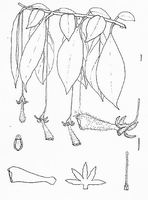
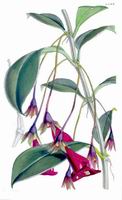
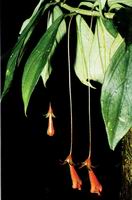
Left: Chautems, Diss. Bot. 112: Fig.12 (1988)
Middle: Bot. Mag. t. 4460 (1849), as Nematanthus ionema
Mart.
Right: Gloxinian 37 (1987): cover illustration, phot. A. Chautems
Full name and orig. publication: Nematanthus Schrad., Gött. Gel. Anz. 1: 718 (5 May 1821), nom. cons.
Etymology: From the Greek νημα, nēma = thread, hair, and άνθος, anthos = flower, referring to the thin pedicels of the often pendulous flowers.
Synonyms: Orobanchia Vand. (1788), nom. rej., Hypocyrta Mart. (1829), p.p., Orobanche Vellozo (1829), non L.
Infrafamilial position: Gesnerioid Gesneriaceae (Gesnerioideae) - Episcieae.
Description: Epiphytic or saxicolous subshrubs or herbs. Stem ascendent, climbing, creeping or pendent, lignescent or woody at base, with fibrous roots from the nodes. Leaves opposite, often anisophyllous, subsessile or petiolate, lamina elliptic or obovate, hard-fleshy, sometimes purple on the lower surface. Axillary cymes 1- to 8-flowered, pedicels short or long and pendent. Sepals shortly connate at base, often coloured. Corolla yellow, orange, red, rose to dark purple, often resupinate; tube cylindrical or gradually widening, sometimes sharply bent at base, usually strongly ventricose, and making an angle of 20-90° with the pedicel, limb with short spreading or reflexed lobes, mouth constricted, orbicular or pentagonal. Stamens 4, didynamous, included; filaments adnate to corolla base; anthers all cohering. Nectary a dorsal, bilobed gland. Ovary superior. Fruit a fleshy, white or variously coloured capsule, included in the persistent calyx, dehiscing loculicidally, exposing the coloured placentae and prominent funicles of the seeds.
Chromosome number: 2n = 16.
Species number: 30.
Species names (incl. publication and synonyms): See Skog, L.E. & J.K. Boggan. 2005: World checklist of Gesneriaceae: http://persoon.si.edu/Gesneriaceae/Checklist.
Type species: Nematanthus corticola Schrad.
Distribution: S & SE Brazil.
Ecology: Mostly epiphytic plants growing on forest trees, especially in montane forests, less commonly on rocks.
Notes: In its present concept Nematanthus is a morphologically diverse genus that includes four types of flowers: (a) hypocyrtoid-non-resupinate (most species of the former genus Hypocyrta Mart.), (b) hypocyrtoid-resupinate, (c) pendent-resupinate; in this case (typical Nematanthus) the solitary flower is exposed on a (to 20 cm long) stalk and has a laterally compressed corolla with wide open mouth; by resupination the ventral pouch becomes located on the upper side, (d) large campanulate white corollas (2 ined. taxa; Chautems, pers. comm.). Pollination in (a)-(c) is apparently by hummingbirds, in (d) by Euglossine bees. The fruit is an apparently ornithochorous display capsule.
Selected references: Wiehler (Selbyana 6: 190 (1983); Chautems, Taxon 36: 656 (1987); Chautems, Diss. Bot. 112: 1-226 (1988), rev.; Araujo, Chautems & Souza, Bol. Bot. Univ. São Paulo 22(1): 43-51 (2004), reg. rev. (Serro do Cipó, Minas Gerais, Brazil); Chautems, Lopes, Peixoto & Rossini, Selbyana 25: 210-224 (2005), new spp.
Bibliography: See Skog, L.E. & J.K. Boggan. 2005. Bibliography of the Gesneriaceae. 2nd edition: http://persoon.si.edu/Gesneriaceae/Bibliography.
Illustrations:
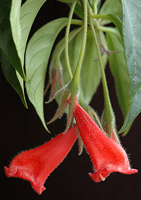
|
Nematathus crassifolius (Schott) Wiehler Plant
of the week, Smithsonian
Institution, |
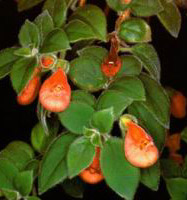
|
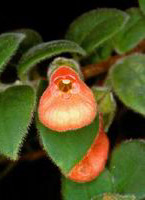
|
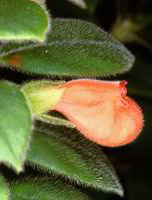
|
Nematanthus bradei (Handro) Chautems
Cult. RBG Edinburgh, phot A.Weber (1998) |
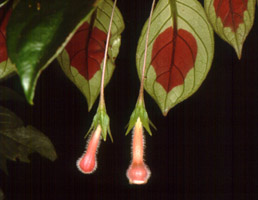 |
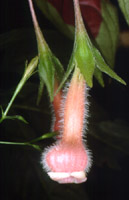 |
Nematanthus fritschii Hoehne Brazil, phot. S. Vogel (2002) |
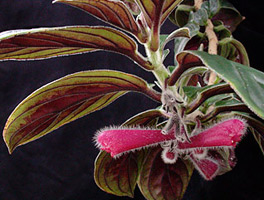
|
Nematanthus monanthos (Vell.) Chautems Plant
of the week, Smithsonian institution, |
last modified: 2007-07-13